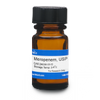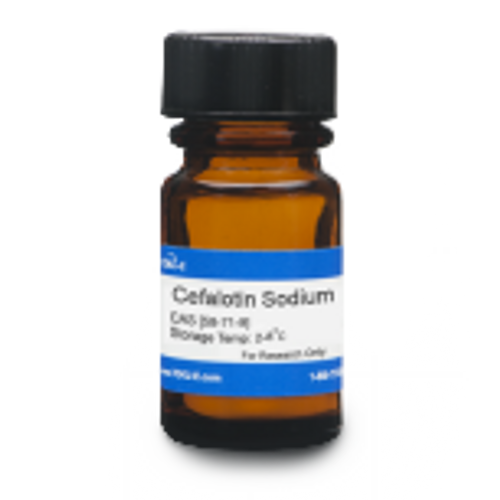Meropenem is a β-lactam antibiotic in the carbapenem class, and targets the bacterial cell wall. It has found utility against extended spectrum β-lactamase (ESBL) producing Enterobacteriaceae that are resistant to many first line β-lactam antibiotics and certain cephalosporins. Meropenem is sparingly soluble in aqueous solution.
We also offer:
| Mechanism of Action | β-lactams interfere with PBP (penicillin binding protein) activity involved in the final phase of peptidoglycan synthesis. PBP’s are enzymes which catalyze a pentaglycine crosslink between alanine and lysine residues providing additional strength to the cell wall. Without a pentaglycine crosslink, the integrity of the cell wall is severely compromised and ultimately leads to cell lysis and death. Resistance to β-lactams is commonly due to cells containing plasmid encoded β-lactamases. Like many carbapenems, Meropenem is highly resistant to the degradative effects of β-lactamases. |
| Spectrum | Meropenem is a broad-spectrum antibiotic targeting a wide range of bacteria especially those causing meningitis. |
| Impurity Profile | Chromotographic Purity: Any two major impurities: Not more than 0.3% Single impurity: Not more than 0.1% Total impurities: Not more than 0.3% |
| Microbiology Applications | Meropenem is commonly used in clinical in vitro microbiological antimicrobial susceptibility tests (panels, discs, and MIC strips) against Gram-positive and Gram-negative microbial isolates. Meropenem has also shown high potency against high-resistant superbug strains.Medical microbiologists use AST results to recommend antibiotic treatment options. Representative MIC values include:
Media SupplementsMeropenem can be used as a selective agent in several types of isolation media: VRE Medium - VRE Selective Supplement |
| Plant Biology Applications | Meropenem can be used to suppress the overgrowth of Agrobacterium in tobacco, tomato, and rice transformation, with 25 mg/L suppressing outgrowth (Ogawa and Mii , 2007). Meropenem suppressed growth of Agrobacterium during transformation of Phalaenopsis at 5 mg/L and had no phytotoxic effect on the cells themselves (Sjahril and Mii, 2005). |
| Molecular Formula | C17H25N3O5S • 3H2O |
| References |
Guzmán F(2008) Beta lactams antibiotics (penicillins and cephalosporins) mechanism of action. Med. Pharmacol. Pharmacology Corner, 29 Nov. 2008 Pitout JD, Sanders CC, Sanders WE (1997) Antimicrobial resistance with focus on beta-lactam resistance in Gram-negative bacilli. Am J Med 103:51 Yang Y, Bhachech N and Bush K (1995) Biochemical comparison of imipenem, Meropenem and biapenem: Permeability, binding to penicillin-binding proteins, and stability to hydrolysis by β-lactamases. J. Antimicrob. Chemother. 35(1):75-84 |
| MIC | Bacteroides caccae| 0.06 - 8|| Bacteroides capillosus | 0.06 - 0.5|| Bacteroides distasonis| 0.06 - 4|| Bacteroides fragilis| 0.008 - 77|| Bacteroides ovatus| 0.06 - 4|| Bacteroides splanchnicus | 0.06 - 0.5|| Bacteroides stercoris| 0.06 - 4|| Bacteroides thetaiotaomicron| 0.06 - 4|| Bacteroides uniformis| 0.06 - 8|| Bacteroides ureolyticus| 0.06 - 0.5|| Bacteroides vulgatus| ≤0.03 - 8|| Bacteroides xylanisolvens | ≥0.25|| Bifidobacterium spp.| 0.03 - 2|| Bilophila wadsworthia| ≥0.06 - 0.12|| Bordetella pertussis | 0.125 - 0.25|| Borrelia burgdorferi S.L.| 0.015 - 0.5|| Burkholderia cepacia| 0.25 - 16|| Burkholderia spp.| 0.25 - 8|| Campylobacter fetus| ≤0.06 - 0.5|| Campylobacter gracilis| 0.06 - 0.25|| Citrobacter freundii| 0.016 - 32|| Citrobacter koseri| ≤0.06|| Citrobacter koseri (Europe)| 0.13|| Citrobacter koseri (North America)| <0.06|| Clostridium bifermentans| ≥0.125|| Clostridium butyricum| ≤0.03 - 1|| Clostridium cadaveris| ≥0.03|| Clostridium clostridioforme| ≤0.03 - 1|| Clostridium difficile| 1 - 4|| Clostridium innocuum| 1 - 2|| Clostridium paraputrificum| ≥0.25|| Clostridium perfringens| ≤0.004 - 0.06|| Clostridium ramosum| ≤0.03 - 2|| Clostridium septicum| ≤0.03 - 1|| Clostridium sordellii| ≥0.06|| Clostridium sporogenes| ≤0.03 - 1|| Clostridium spp.| ≤0.004 - 4|| Enterobacter aerogenes| ≤0.008 - 16|| Enterobacter cloacae| ≤0.008 - 16|| Enterobacteriaceae| 0.15 - 4|| Enterococci| 0.004 - 128|| Enterococcus faecalis| 1 - 64|| Enterococcus faecium| 1 - >128|| Enterococcus gallinarum| ≥15.6|| Escherichia coli| ≤0.007 - >32|| Eubacterium lentum| 0.06 - 8|| Eubacterium limosum| 0.06 - 0.5|| Eubacterium spp.| 0.008 - 0.25|| Finegoldia magna| 0.06 - 0.25|| Fusobacterium mortiferum| ≤0.03 - 8|| Fusobacterium necrophorum| ≤0.016 - 8|| Fusobacterium nucleatum| 0.008 - 8|| Fusobacterium spp.| ≤0.004 - 8|| Fusobacterium varium| ≤0.03 - 8|| Gram-Positive Anaerobic Cocci| 0.03 - 0.12|| Haemolytic streptococci| 0.002 - 0.06|| Haemophilus influenzae| 0.016 - 1|| Haemophilus spp.| 0.015 - 0.25|| Klebsiella aerogenes (1522E)| ≥0.05|| Klebsiella pneumonia| 0.008 - >32|| Lactobacillus catenaforme| 0.06 - 0.5|| Lactobacillus jensenii| 0.06 - 0.5|| Lactobacillus spp.| 0.06 - 4.0625|| Micromonas micros| 0.03 - 0.125|| Moraxella catarrhalis| 0.002 - ≤0.016|| Morganella morganii| 0.03 - 0.5|| Neisseria meningitidis| 0.03 - 0.016|| Neisseria spp.| 0.002 - 0.03|| Nonsporing gram-positive rods| 0.03 - 8|| Pandoraea apista| 1 - >32|| Pandoraea genomo| ≥32|| Pandoraea pnomenusa| ≥32|| Pantoea agglomerans| 0.12|| Parvimonas micra| 0.047 - 0.38|| Pemphigus mirabilis| 0.06 - 4|| Pemphigus vulgaris| 0.13 - 0.25|| Peptoniphilus asaccharolyticus| ≤0.016 - 0.125|| Peptoniphilus gorbachii | 0.004 - 0.064|| Peptoniphilus harei | 0.004 - 0.032|| Peptoniphilus ivorii | 0.002 - 0.016|| Peptoniphilus lacrimalis | 0.002 - 0.016|| Peptoniphilus octavius | ≥0.094|| Peptostreptococcus anaerobius| 0.023 - 8|| Peptostreptococcus magnus| ≤0.03 - 4|| Peptostreptococcus micros| ≤0.03 - 4|| Peptostreptococcus spp.| ≤0.004 - 4|| Pneumococci| 0.002 - 16|| Porphyromonas asaccharolytica| ≤0.016 - 0.12|| Porphyromonas endodontalis | 0.06 - 0.12|| Porphyromonas gingivalis| ≤0.016 - 1|| Porphyromonas levii | ≤0.016|| Porphyromonas spp.| 0.031 - 8|| Prevotella bivia| 0.03 - 2|| Prevotella buccae| 0.06 - 1|| Prevotella corporis | ≤0.016 - 0.06|| Prevotella denticola| ≤0.016 - 0.06|| Prevotella disiens| 0.03 - 2|| Prevotella intermedia| ≤0.016 - 2|| Prevotella loescheii| 0.06 - 0.12|| Prevotella melaninogenica| ≤0.016 - 0.25|| Prevotella melaninogenicus | 0.06 - 1|| Prevotella nigrescens| ≤0.016 - 2|| Prevotella oralis| 0.06 - 1|| Prevotella oris| 0.03 - 0.25|| Prevotella spp.| 0.03 - 1|| Propionibacterium acnes| 0.06 - 0.5|| Proteus mirabilis| 0.031 - 0.5|| Proteus rettgeri| ≤0.12|| Proteus spp.| ≤0.06 - 0.5|| Proteus vulgaris| 0.03 - 0.25|| Providencia rettgeri| 0.032 - >32|| Providencia spp.| ≤0.06 - >32|| Providencia stuartii | 0.25 - 2|| Pseudomonas aeruginosa| 0.008 - >128|| Pseudomonas spp.| 0.15 - 16|| Ralstonia pickettii (PIC-1)| ≥2|| Ruminococcus gnavus| ≥0.125|| Salmonella spp.| 0.12|| Salmonella typhimurium| ≥0.05|| Serratia marcescens| ≤0.016 - >128|| Staphylococci| 0.015 - >128|| Staphylococcus aureus| ≤0.06 - 64|| Staphylococcus epidermidis| 0.06 - 64|| Stenotrophomonas maltophilia| 0.25 - 128|| Streptococci| ≤0.016 - 0.12|| Streptococcus agalactiae| 0.016 - 32|| Streptococcus faecalis| 31.3 - ≥500|| Streptococcus pneumonia| 0.008 - 2|| Streptococcus pyogenes| ≤0.004 - 0.008|| Sutterella wadsworthensis| 0.03 - >32|| Veillonella parvula| ≤0.03 - 0.5|| Veillonella spp.| ≤0.004 - 0.5|| |








